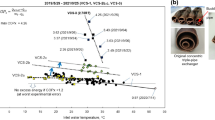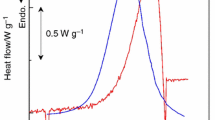Abstract
In the context of chemical evolution a simulation of a hydrothermal vent was performed. The thermolysis and radiolysis of malonic acid in aqueous solution were studied. The thermolysis was done by heating the samples (95 °C) and radiolysis using gamma radiation. Products were identified by gas chromatography and gas chromatography–mass spectrometry. The thermal treatment produced acetic acid and CO2. The radiolysis experiments yield carbon dioxide, acetic acid, and di- and tricarboxylic acids. A theoretical model of the chemical process occurring under irradiation was developed; this was able to reproduce formation of products and the consumption of malonic acid.






Similar content being viewed by others
References
Perry RS, Kolb VM (2004) On the applicability of Darwinian principles to chemical evolution that led to life. Int J Astrobiol 3(1):45–53
Negrón-Mendoza A, Ramos-Bernal S (2000) In: Chela-Flores J, Lemarchand G, Oró J (eds) Astrobiology: origins from the Big Bang to civilization. Kluwer Academic Publisher, Dordrecht, pp 71–84
Miller SL, Orgel L (1974) The origins of life on earth. Prentice-Hall, Inc., Eagle Cliffs
Draganic IG, Draganic ZD, Adloff JP (1990) Radiation and radioactivity. CRC Press Inc, Boca Raton
Negrón-Mendoza A, Albarrán G (1993) In: Ponnamperuma C, Chela-Flores J (eds) Chemical evolution: origin of life. Deepak Publishers, Hampton, pp 147–235
Muller AWJ, Schulze-Makuch D (2006) Thermal energy and the origin of life. Orig Life Evol Biosph 36:177–189
Russell MJ, Hall AJ (2009) A hydrothermal source of energy and materials at the origin of life. Chemical evolution II: from origins of life to modern society. American Chemical Socity, Washington,DC, pp 45–62
Russell MJ, Hall AJ, Martin W (2010) Serpentinization and its contribution to the energy for the emergence of life. Geobiology. doi:10.1111/j.1472-4669.2010.00249.x
Corliss JB, Baross JA, Hoffman SE (1981) An hypothesis concerning the relationship between submarine hot springs and the origin of life on Earth. Oceanol Acta 4:59–69
Wächtershäuser G (1988) Before enzymes and templates: theory of surface metabolism. Microbiol Rev 52:452–484
Holm NG, Charlou JL (2001) Initial indications of abiotic formation of hydrocarbons in the rainbow ultramafic hydrothermal system, Mid-Atlantic Ridge. Earth Planet Sci Lett 191:1–8
Holms N, Andersson E (2005) Hydrothermal simulation experiments as a tool for studies of the origin of life on earth and other terrestrial planets: a review. Astrobiology 5(4):444–460
Martin W, Baross J, Kelley D, Russell MJ (2008) Hydrothermal vents and the origin of life. Nat Rev Microbiol 6:805–814
Wächtershäuser G (2010) In: Barton LL, Mandl M, Loy A (eds) Geomicrobiology: molecular and environmental perspecstive. Springer, Dordrecht
Stüeken EE, Anderson RE, Bowman JS, Brazelton WJ, Colangelo-Lillis J, Goldman AD, Som SM, Baross JA (2013) Did life originate from a global chemical reactor? Geobiology 11(2):101–126
Miller SL, Bada JL, Friedmann N (1989) What was the role of submarine hot springs in the origin of life? Orig Life Evol Biosph 19:536–537
Kelley DS, Karson JA, Früh-Green GL, Yoerger DR, Shank TM et al (2005) A serpentinite-hosted ecosystem: the Lost City hydrothermal field. Science 307:1428–1434
Baross JA, Hoffman SE (1985) Submarine hydrothermal vents and associated gradient environments as sites for the origin and evolution of life. Orig of Life 15:327–345
Draganic I, Bjergbake E, Draganic Z, Sehested K (1991) Decomposition of ocean waters by 40K radiation 3800 Ma ago as a source of oxygen and oxidizing species. Precambrian Res 52:337–345
Miller S (1953) A production of amino acids under possible primitive Earth conditions. Science 117:528–529
Miller S, Urey H (1959) Organic compound synthesis on the primitive Earth. Science 130:245–251
Negrón-Mendoza A, Ponnamperuma C (1978) In: Noda H (ed) Origins of life. Center of Scientific Publications, Tokyo, pp 101–104
Negrón-Mendoza A, Ponnamperuma C (1982) Prebiotic formation of higher molecular weight compounds from the photolysis of aqueous acetic acid. Photochem Photobiol 36:595
Lawless JG, Zeitman B, Pereira WE, Summons RE, Duffield AM (1974) Dicarboxylic acids in the Murchison meteorite. Nature 251:40–42
O’Donnell JHO, Sangster DF (1970) Principles of radiation chemistry. Elsevier, New York
Draganic ID, Draganic ZD (1971) The radiation chemistry of water. Academic Press, New York
Negrón-Mendoza A, Castillo S, Torres JL (1984) Microdeterminación de gases disueltos en soluciones acuosas por cromatografía de gases (in Spanish). Rev Soc Quím Mex 28:21–24
Negrón-Mendoza A, Draganic Z, Navarro R, Draganic IG (1983) Aldehydes, ketones and carboxylic acids formed radiolitically in aqueous solutions of cyanides and nitriles. Radiat Res 95:248–261
Shampine LF (1994) Numerical Solution of Ordinary Differential Equations. Chapman and Hall, New York
Sanchez-Mejorada G, Frias D, Negrón-Mendoza A, Ramos-Bernal S (2008) A comparison between experimental results and a mathematical model of the oxidation reactions induced by radiation of ferrous ions. Radiat Meas 43:287–290
Simic M, Neta P, Hayon E (1969) Pulse radiolysis of aliphatic acids in aqueous solutions. II. Hydroxy and polycarboxylic acids. J Phys Chem 73:4214–4219
Sagstuen E, Lund A, Itagaki Y, Maruani J (2000) Weakly coupled proton interactions in the malonic acid radical: single crystal ENDOR analysis and EPR simulation at microwave saturation. J Phys Chem A 104:6362–6371
Kang J, Tokdemir S, Shao J, Nelson WH (2003) Electronic g-factor measurement from ENDOR-induced EPR patterns: malonic acid and guanine hydrochloride dihydrate. J Magn Reson 165:128–136
Yamamoto S, Back RA (1985) The photolysis and thermolysis of pyruvic acid in the gas phase. Can J Chem 63:549–553
Yamamoto S, Back RA (1985) The gas phase photochemistry of oxalic acid. Can J Chem 63:622–625
Back RA, Yamamoto S (1985) The gas phase photochemistry and thermal decomposition of glyoxylic acid. Can J Chem 63:542–548
Cao JR, Back RA (1986) The thermolysis and photolysis of malonic acid in gas phase. Can J Chem 64:967–968
Mosqueira FG, Albarran G, Negrón-Mendoza A (1996) A review of conditions affecting the radiolysis due to 40K on nucleic acid bases and their derivatives adsorbed on clay minerals: implications in prebiotic chemistry. Orig Life Evol Biosph 26:75–94
Draganic IG, Draganic ZD, Altiparmako D (1983) Natural nuclear reactors and ionizing radiation in the Precambrian. Precambrian Res 20:283–298
Acknowledgments
PAPIIT Grant No. IN110712 and CONACYT Grant No. 168579 supported this work. JCC was supported by a CONACyT fellowship. The support of the “Posgrado en Ciencias Químicas” through the invitation to Prof. D. Frías is acknowledged. We also thank C. Camargo, B. Leal and F. Flores for their technical support. We thank to the reviewers for their very useful comments and suggestions to improve the manuscript.
Author information
Authors and Affiliations
Corresponding author
Rights and permissions
About this article
Cite this article
Cruz-Castañeda, J., Negrón-Mendoza, A., Frías, D. et al. Chemical evolution studies: the radiolysis and thermal decomposition of malonic acid. J Radioanal Nucl Chem 304, 219–225 (2015). https://doi.org/10.1007/s10967-014-3711-z
Received:
Published:
Issue Date:
DOI: https://doi.org/10.1007/s10967-014-3711-z




